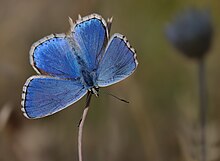Lysandra corydonius
Appearance
You can help expand this article with text translated from the corresponding article in Russian. (April 2023) Click [show] for important translation instructions.
|
| Lysandra corydonius | |
|---|---|

| |
| Scientific classification | |
| Domain: | Eukaryota |
| Kingdom: | Animalia |
| Phylum: | Arthropoda |
| Class: | Insecta |
| Order: | Lepidoptera |
| Family: | Lycaenidae |
| Genus: | Lysandra |
| Species: | L. corydonius
|
| Binomial name | |
| Lysandra corydonius (Herrich-Schäffer, [1852])[1]
| |
| Synonyms | |
| |
Lysandra corydonius, the false chalkhill blue, is a butterfly of the family Lycaenidae. The species is distributed in south-eastern Europe, Caucasus, Transcaucasia, north-eastern Turkey, and north-western Iran.[1][2] L.corydonius is very similar to Lysandra coridon but a slight violet sheen is present, especially in the outer area of the wings.[3] It inhabits a wide variety of grasslands and woodlands. In Armenia it occurs from 1200 to 2000 m above sea level.[4] The known larval host plants of the species in Turkey is Hippocrepis comosa,[1] in the Caucasus - Coronilla varia.[5] The species has not been assessed for the IUCN Red List. In Armenia from 2003 to 2013 its population increased.[4]
Subspecies
- Lysandra corydonius corydonius (Caucasus, Transcaucasus, north-eastern Turkey, north-western Iran)
- Lysandra corydonius ciscaucasica (Jachontov, 1914) (northern Caucasus, south-eastern Europe)
References
- ^ a b c "Lysandra Hemming, 1933" at Markku Savela's Lepidoptera and Some Other Life Forms
- ^ Tshikolovets, V.V. - Butterflies of Eastern Europe, Urals and Caucasus. in Kyiv, Brno, 176 pp. 2003
- ^ Seitz, A. in Seitz, A. ed. Band 1: Abt. 1, Die Großschmetterlinge des palaearktischen Faunengebietes, Die palaearktischen Tagfalter, 1909, 379 Seiten, mit 89 kolorierten Tafeln (3470 Figuren)
- ^ a b Butterfly Conservation Armenia http://www.butterfly-conservation-armenia.org/polyommatus-coridonius.html
- ^ "Polyommatus (Lysandra) corydonius - Голубянка коридоний".
